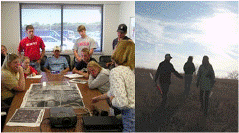Environmental Studies Program
Date of this Version
Spring 2015
Citation
Environmental Studies Undergraduate Student Thesis, University of Nebraska–Lincoln, 2015
Abstract
This investigational study conducted in Lincoln, Nebraska seeks to explore the link between geographic and economic barriers to food access. Food access is a problem in the United States. 29 percent of U.S. ZIP codes do not contain a grocery store or supermarket. Families also face barriers to food economically, as low income individuals are less able to afford food. Through the use of ArcGIS 10.2.2 for Desktop software this project seeks to visually represent the areas in which access to food is limited both geographically and financially. Creating one mile buffer zones around each grocery store in Lincoln, Nebraska and cross referencing that information with median household income data from the 2013 U.S. Census Bureau a map of “at-risk” food deserts was created. It was found that in Lincoln three food deserts exist, and coincide with the lowest income neighborhoods. An Environmental Justice issue was also uncovered, demonstrating patterns consistent with the United States that these “at-risk” food deserts show a higher population of minorities than non-food desert areas.


Comments
Copyright © 2015 Samantha Corr